

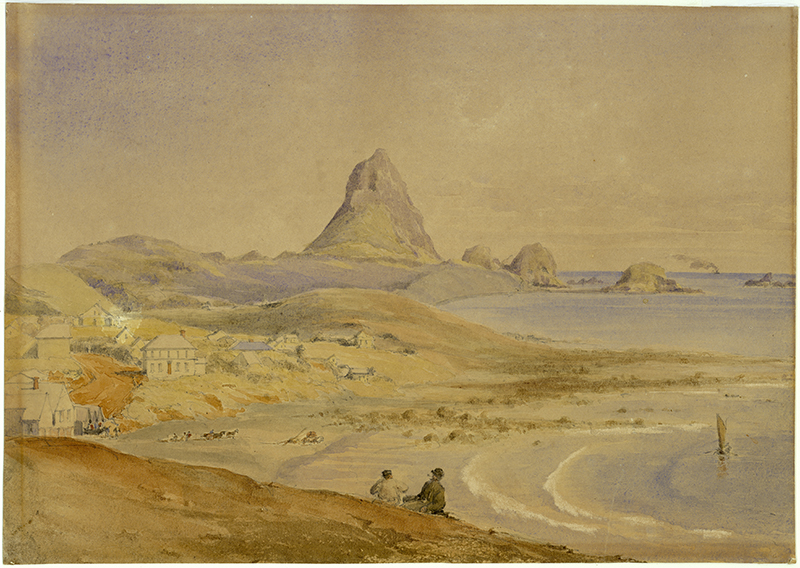
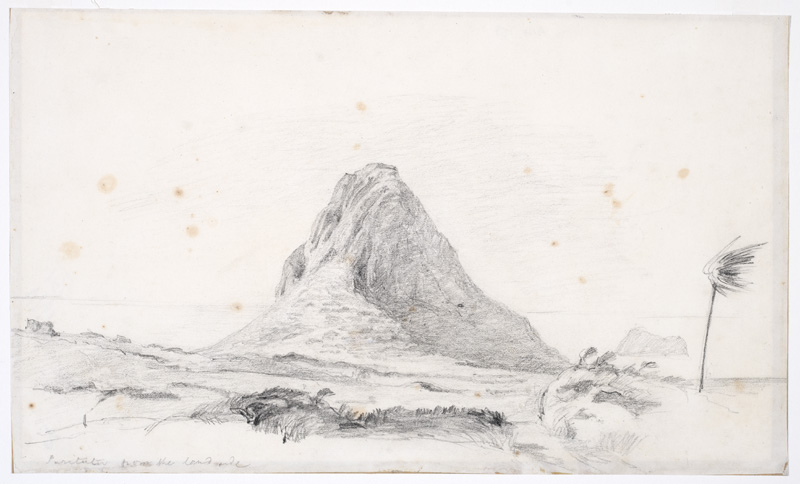
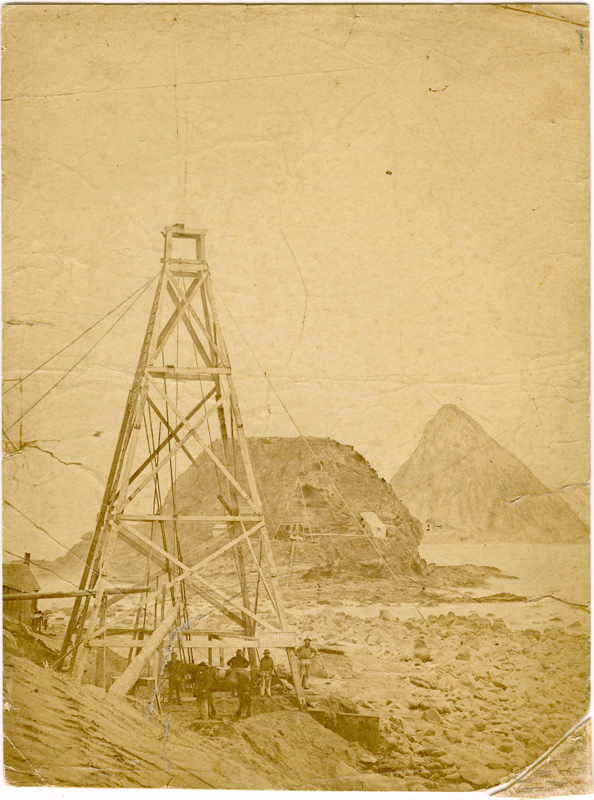
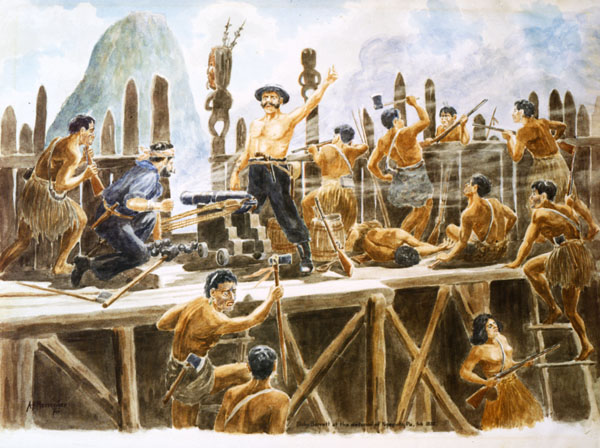
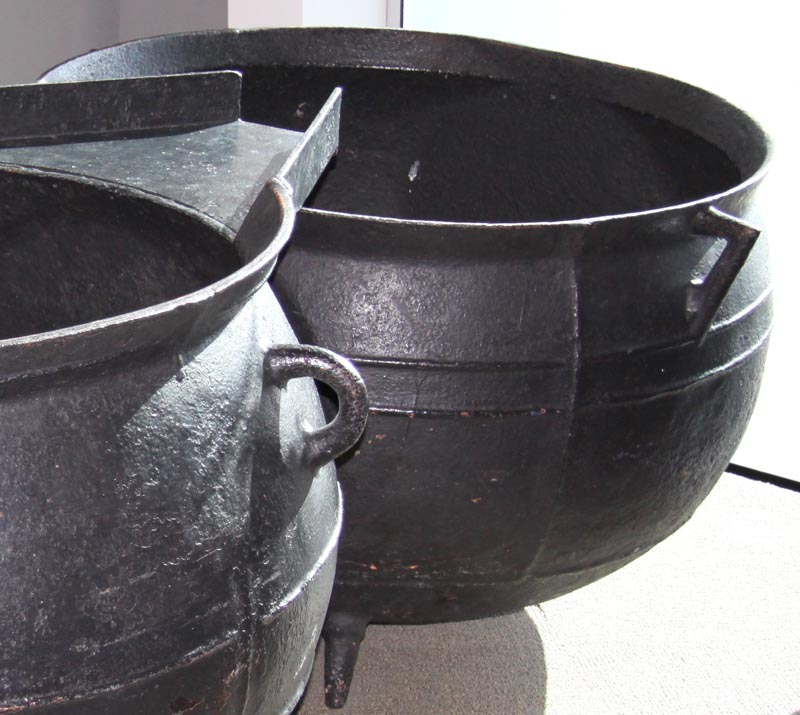
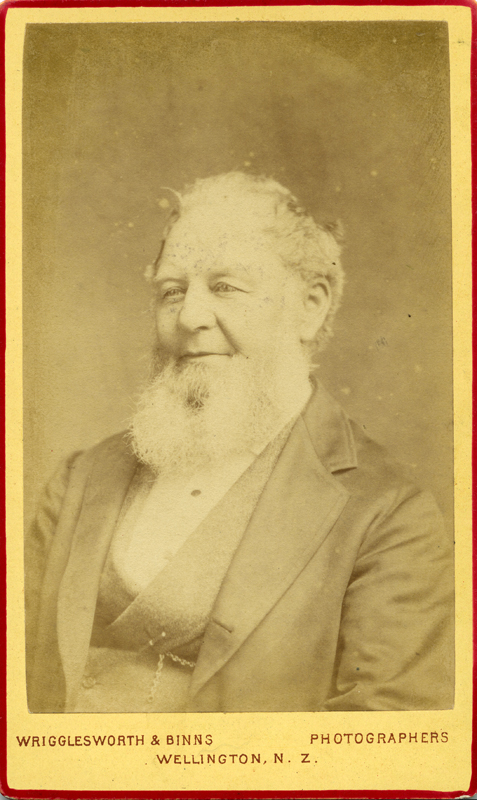
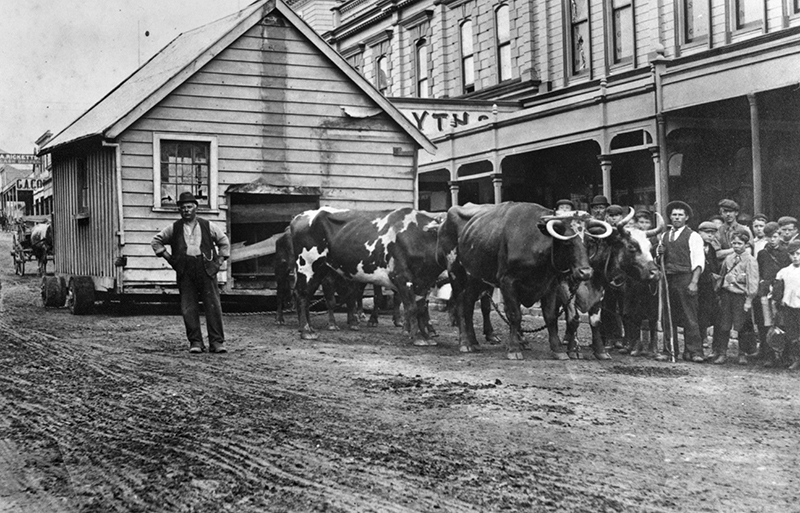
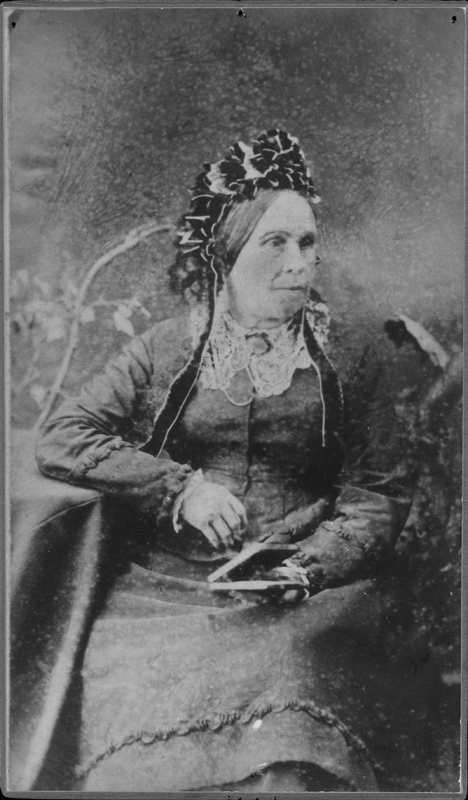

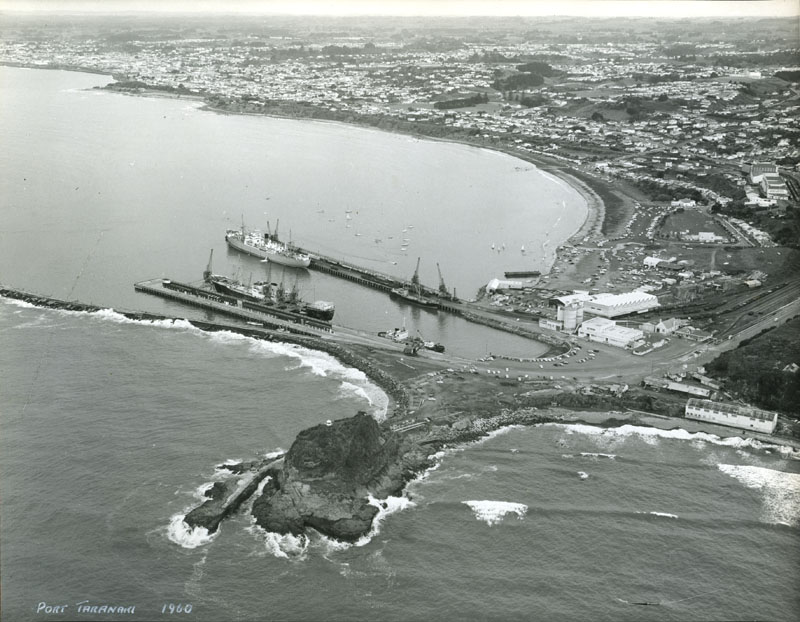
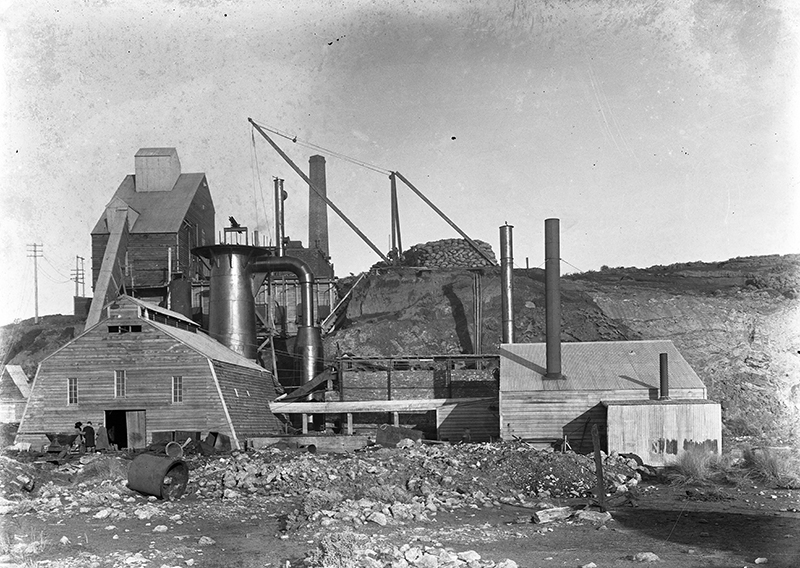

If the black grains of sand on New Plymouth's Ngāmotu Beach could talk they would tell tales of tragedy and triumph, of pounding warriors' feet, the crack of cannon fire, the creaking of oars from boats and the steady development of a village turned town, turned city. Once a large sprawling beach, Ngāmotu has played an important part in both Māori and European history.
Close your eyes and imagine - a crescent of shimmering black sand curves along the coastline, white capped waves crash on shore. Driftwood piles above the high tide mark, overhung by native bush and flax. At one tip of the crescent the mitre-peaked Paritutū rises majestically above the waves, the tide licking her toes. In Paritutū's shadow the meandering Hongi Hongi stream curves around the mighty Ōtaka pā, flanked by the little fishing kainga (village) of Mataipu. This is home to Ngāti Te Whiti, of Te Ātiawa. A group of women till the land, planting kūmara and gourd. Children play in the waves. Offshore, men in waka fish among a group of scrub clad islands. This is Ngāmotu before shoe-clad white feet touched its shores.
The west coast of Aotearoa is known for its wild seas - the lack of a natural port meant that, even as late as 1820, Māori at Ngāmotu had not seen Pākehā. Captain Cook had anchored offshore 50 years before, but had been put off landing by the rolling surf that crashed onto the beach. One of the first Europeans to land in the area was possibly John Kent when he arrived on HMS Elizabeth Henrietta in 1823, on a trip to collect plant specimens.
But sometime in previous years another European ship had visited and now Māori knew that white men brought iron tools, woollen blankets and muskets. So they were prepared when Dicky Barrett arrived offshore on the Adventure in 1828. They offered flax and pigs, but Dicky had bigger plans in mind and a trading relationship soon developed.
Dicky and his business partner John Love, one brown haired and squat - the other fair and tall, set up a trading post at Ngāmotu among the Ngāti Te Whiti and settled 10 traders there. The partners did more than trade with Te Ātiawa - they eased their way into Māori society for economic gain. They became Pākehā -Māori, took Māori wives and were given Māori names. Dicky Barrett became Tiki Pārete while John Love became simply Hakirāu.
In early 1832 Dicky and John became involved in a battle when Ōtaka pā was attacked by invading Waikato fresh from their attack on Pukerangiora pā on the banks of the Waitara River. From the fortifications of Ōtaka the torch light of Te Whero Whero's army could be seen marching through the darkness - a terrifying vision for those huddled in the pā.
After a long battle Ngāti Te Whiti were victorious, thanks largely to three cannon belonging to Barrett and Love. On the eve of this bloody battle it is said a baby was born behind the palisades in the pā above the sea - the future pacifist leader Te Whiti-o-Rongomai was whisked away to safety before the warriors arrived.
Although they were triumphant the iwi were still under constant threat from marauding tribes, so made the decision to move south to the Cook Strait area. Ngāmotu was virtually abandoned.
In 1839 Dicky Barrett returned to the shores where he set up a short-lived whaling station. In season a mishmash of try pots, harpoons, windlasses and long boats were collected on the beach, ready for a shout from a lookout high on Paritutū. When a whale was spotted there would be a frenzied rush for the boats and the open sea. Once caught its carcase was floated back to Ngāmotu where it was stripped of baleen and oil and the remains were left to rot on the sand.
It was at Ngāmotu that Dicky Barrett translated the New Zealand Company's impressive deeds of sale - the resulting dodgy deal saw 77 chiefs cheerfully sell lands to which they had no interest. Plans were immediately set in motion for the first load of Europeans to settle on the new land.
When Fredric Carrington, chief surveyor for the Plymouth Company waded ashore through the surf crashing on the black sands of Ngāmotu on 12 February 1841 he didn't see the scrubby bush and fern that lay before him but rows of neat houses marching across the landscape. He'd been sent to find land for a township and, despite the lack of a harbour, had decided this stretch of coastline was perfect for New Plymouth. The settlers were on their way so he had to get to work.
Just six weeks later infant Levi Sarten, followed closely by his mother Lucy, became the first European settler to set foot on Ngāmotu Beach. But the new arrivals were disappointed - after months at sea they arrived to find their much dreamed of land was not ready and they were to sleep in raupō huts and tents. There were no horses or bullocks so they had to drag their worldly goods along the black sands of Ngāmotu themselves.
The passengers were met by Reverend Charles Creed who, along with his wife Eliza were setting up a mission at Ngāmotu. By September 1841 pious settlers could worship in newly built chapel overlooking the crashing waves below Paritutū's peak. Schools for Māori boys and girls were to follow.
Passengers on the William Bryan were the only ones to embark at Ngāmotu - other arrivals went direct to the township, the ships anchoring off the Huatoki river mouth.
The lack of port was a problem for the little township - supplies and passengers had to be rowed by boat through the rolling surf - often struggling wet and miserable to shore. Finally in 1881, 40 years after selecting the site of the town, Frederic Carrington laid the foundation stone for the first breakwater at Ngāmotu.
The port was to prove the town's lifeline - soon butter, cheese and meat were being exported from the little wharf, more settlers were arriving and the township of New Plymouth was expanding.
As the town and region of Taranaki grew - so did the port. In 1897, the breakwater lay nearly 600 metres out to sea, protecting the port and new shipping trade so important to a growing province. But as the port grew Ngāmotu Beach began to disappear, shrinking under the ever expanding commercial entity.
Early settlers arriving on New Plymouth's shores had been amazed at the black iron sand beaches, “wealth spread out as a carpet” as one man wrote home to his family. But attempts to turn the sand into iron were never commercially successful. In 1914, a young mining engineer named John A. Heskett gained financial backing and set up a large smelting plant at Paritutū naming it the New Zealand Iron Ore Smelting and Manufacturing Company. It was to be the last attempt to make some commercial use of the local iron sands.
The company expected to make 140 tons of pig iron a week, expecting a big demand. But the market wasn't there and in 1921 the company was closed down, the equipment being shipped to Nelson.
It was near today's breakwater, in the shadow of Paritutū, that New Zealand's first oil deposit was discovered. For years settlers had been complaining about the oily scum on Ngāmotu Beach that required them to wipe their boots and lift their dresses when they walked along the sand. Rainbow hued slicks often covered the water around the Sugar Loaf Islands and local Māori told of an atua (spirit) who drowned there and was still undergoing decomposition. Oil was literally flowing off the beach - but it wasn't until 1865 that anything was done about it.
Four intrepid men hand dug the Alpha Well and kick-started an industry that was to be more bust than boom. Ngāmotu became dotted with derricks as oil pioneers rushed to cash in on the black gold oozing from the sand. Over the years refineries were built to process the small amounts of oil flowing from the successive wells - with moderate success. The Moturoa field produced around 500,000 barrels of oil from the 1860s to the mid-1970s.
In the early 20th Century Ngāmotu became the province's playground. The breakwater tamed the waves and provided a safe bathing area. In 1917 when the new palladium tearooms had just been completed, the beach was grandly billed as ‘the play-shore of the Pacific’.
Its New Year's Day picnics drew families from around the province - excursion trains ran from Whangamomona and south Taranaki. School and church groups crowded the sand. Parents taught their children to swim in the safe waters. Baches sprung up along the water front - an eclectic collection of colourful cottages on farmland fast disappearing under suburban sprawl.
During World War Two life on the beach died. Concrete pillboxes were constructed above the high tide mark, soldiers occupied some of the cottages along the shore front and guards prevented anyone going on the beach at night. The tea rooms had to close.
But after the war, life picked up again. A skating rink, miniature railway, sound shell and a crazy golf course were built. Bathing and sailing became popular. A fairground atmosphere developed as an annual Mardi Gras was held on the sand between Pioneer Road and the Hongi Hongi stream. Marching girls, fairground attractions, talent quests and bands attracted thousands of locals and visitors.
But from the late 1950s with more cars, other attractions and the growing trend for families to split up for recreational pursuits the beach began to suffer from the competition. The last carnival was held at the beach in 1966. By then the Taranaki Harbours Board had begun its port expansion which included a third wharf on the western half of the beach. The area of black sand gradually shrank as the port gradually gobbled up the beach.
Today Ngāmotu huddles compactly below Paritutū. The once bush clad hills overlooking the little beach are now covered with closely packed houses. Cargo containers, ships and storage sheds replace the little fishing kainga and the Hongi Hongi stream outlet is now a culvert. Children playing in the waves gaze up at large ships from exotic international ports. But the spirit of the beach remains -a little stretch of black sand that has witnessed so much of our history.
Puke Ariki Heritage Collection: Ngāmotu
LinkPlease do not reproduce these images without permission from Puke Ariki.
Contact us for more information or you can order images online here.